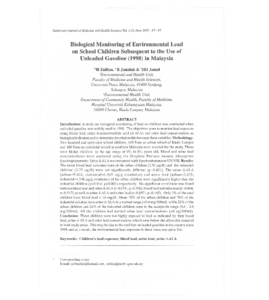Citation
Hashim, Zailina and Raib, Junidah and Hashim, Jamal Hisham
(2005)
Biological monitoring of environmental lead on school children subsequent to the use of unleaded gasoline (1998) in Malaysia.
Malaysian Journal of Medicine and Health Sciences, 1 (2).
pp. 87-95.
ISSN 1675-8544
Abstract
was widely used in 1998. The objectives were to monitor lead exposure using blood lead, urine δ-aminolevulinic acid (δ-ALA) and urine lead concentrations as biological indicators and to determine the relationship between these variables. Methodology: Two hundred and sixty nine school children, 169 from an urban school of Kuala Lumpur and 100 from an industrial school in southern Malaysia were selected for the study. These were Malay children in the age range of 6 ½ to 8 ½ years old. Blood and urine lead concentrations were analyzed using the Graphic Furnace Atomic Absorption Spectrophotometer. Urine δ-ALA was measured with Spectrophotometer UV/VIS. Results: The mean blood lead concentrations of the urban children (3.56 μg/dl) and the industrial children (3.75 μg/dl) were not significantly different (p=0.451). The urine δ-ALA (urban=9.606; industrial= 6.965 mg/g creatinine) and urine lead (urban=2.625; industrial=4.548 μg/g creatinine) of the urban children were significantly higher than the industrial children (p=0.014: p<0.001) respectively. No significant correction was found between blod lead and urine δ-ALA (r=0.058; p=0.165). Only 2% of the total children have blood lead > 10 mg/dl. About 78% of the urban children and 76% of the industrial children have urine δ-ALA in a normal range (<0.6 mg/100ml) while 22% of the urban children and 24% of the industrial children were in the acceptable range (0.6 – 2.0 mg/100ml). All the children had normal urine lead concentrations (<8 μg/100ml). Conclusion: These children were not highly exposed to lead as indicated by their blood lead, urine δ-ALA and urine lead concentrations which were below the allowable standard in both study areas. This may be due t the total ban on leaded gasoline in the country since 1998 and as a result, the environment lead exposure in these areas was quite low.
Download File
![[img]](http://psasir.upm.edu.my/41129/1.hassmallThumbnailVersion/Biological%20monitoring%20of%20environmental%20lead%20on%20school%20children%20subsequent%20to%20the%20use%20of%20unleaded%20gasoline%20%281998%29%20in%20Malaysia.pdf)  Preview |
|
PDF
Biological monitoring of environmental lead on school children subsequent to the use of unleaded gasoline (1998) in Malaysia.pdf
Download (3MB)
| Preview
|
|
Additional Metadata
Actions (login required)
 |
View Item |

